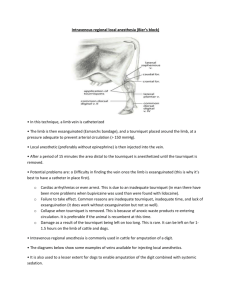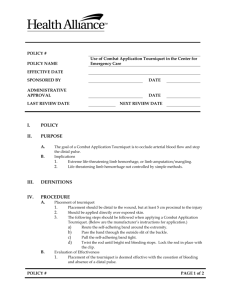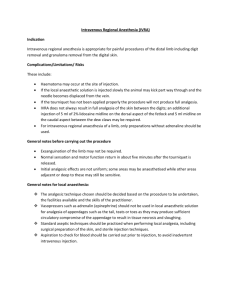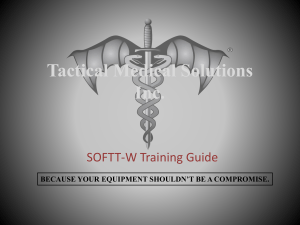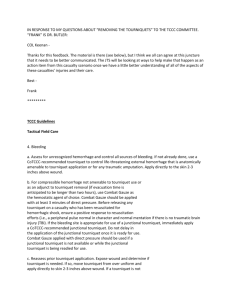Total joint replacement - Questions 80. Use of methylmethacrylate
advertisement
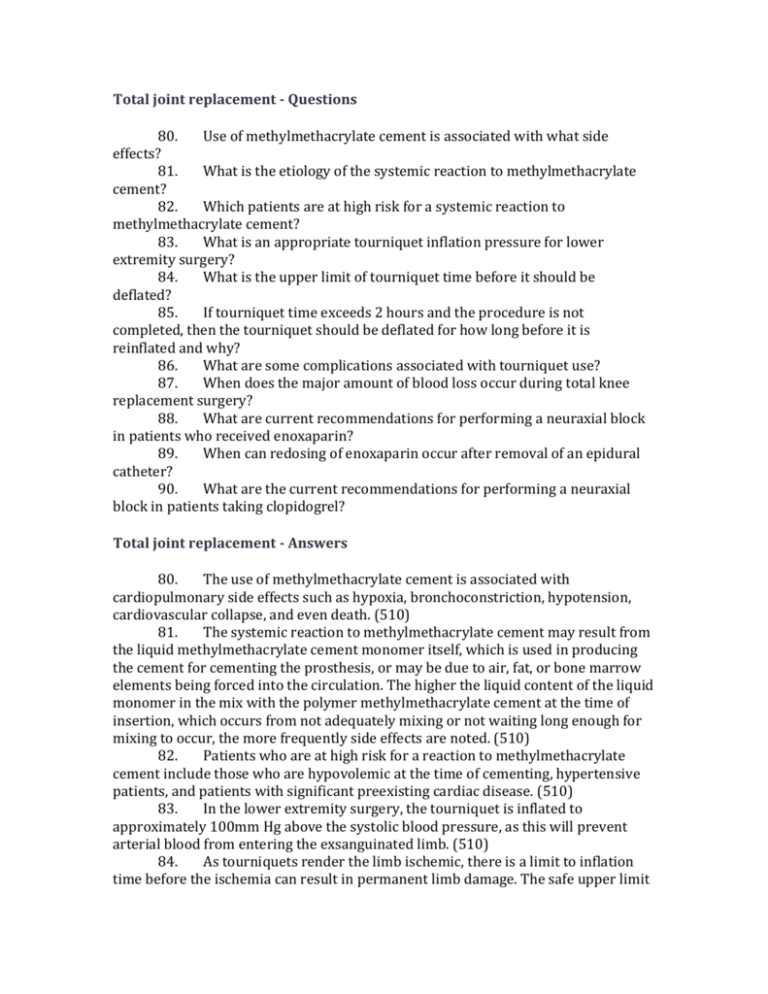
Total joint replacement - Questions 80. Use of methylmethacrylate cement is associated with what side effects? 81. What is the etiology of the systemic reaction to methylmethacrylate cement? 82. Which patients are at high risk for a systemic reaction to methylmethacrylate cement? 83. What is an appropriate tourniquet inflation pressure for lower extremity surgery? 84. What is the upper limit of tourniquet time before it should be deflated? 85. If tourniquet time exceeds 2 hours and the procedure is not completed, then the tourniquet should be deflated for how long before it is reinflated and why? 86. What are some complications associated with tourniquet use? 87. When does the major amount of blood loss occur during total knee replacement surgery? 88. What are current recommendations for performing a neuraxial block in patients who received enoxaparin? 89. When can redosing of enoxaparin occur after removal of an epidural catheter? 90. What are the current recommendations for performing a neuraxial block in patients taking clopidogrel? Total joint replacement - Answers 80. The use of methylmethacrylate cement is associated with cardiopulmonary side effects such as hypoxia, bronchoconstriction, hypotension, cardiovascular collapse, and even death. (510) 81. The systemic reaction to methylmethacrylate cement may result from the liquid methylmethacrylate cement monomer itself, which is used in producing the cement for cementing the prosthesis, or may be due to air, fat, or bone marrow elements being forced into the circulation. The higher the liquid content of the liquid monomer in the mix with the polymer methylmethacrylate cement at the time of insertion, which occurs from not adequately mixing or not waiting long enough for mixing to occur, the more frequently side effects are noted. (510) 82. Patients who are at high risk for a reaction to methylmethacrylate cement include those who are hypovolemic at the time of cementing, hypertensive patients, and patients with significant preexisting cardiac disease. (510) 83. In the lower extremity surgery, the tourniquet is inflated to approximately 100mm Hg above the systolic blood pressure, as this will prevent arterial blood from entering the exsanguinated limb. (510) 84. As tourniquets render the limb ischemic, there is a limit to inflation time before the ischemia can result in permanent limb damage. The safe upper limit of ischemia time is considered to be 2 hours. The surgeon should be informed of tourniquet inflation time at 1 hour and then as the tourniquet approaches the 2hour limit so it can be deflated in a timely manner. (511) 85. If the total tourniquet time will exceed the 2-hour limit, the tourniquet should be deflated at 2 hours for a period of at least 15 to 20 minutes before it is reinflated. This will allow for the “wash-out” of acidic metabolites from the ischemic limb as the limb is reperfused with oxygenated blood. Recirculation of the ischemic limb with release of the tourniquet is noted by a decrease in blood pressure and an increase in end-tidal carbon dioxide as the acid products recirculate. The hypotension usually responds to intravascular fluid administration and vasopressors if necessary. (510) 86. Complications associated with tourniquet use include nerve damage, vessel damage especially in patients with atherosclerosis, pulmonary embolism, and skin damage. One source of skin damage is the antiseptic prep solution, if it is allowed to seep under the tourniquet and tourniquet padding at the time of skin prep, causing a chemical burn. Additional concerns at the time of tourniquet deflation are pulmonary embolism and a decrease in core temperature as the isolated extremity is reperfused. (510) 87. During total knee replacement surgery a tourniquet is used, and in the operating room blood loss is usually not significant. However, if much blood loss occurs into drains in the PACU, hypotension may result. Some surgeons do not deflate the tourniquet until the wound is closed and the dressing is on the patient. In this situation blood loss is usually less but there is a risk of bleeding. (510) 88. Consensus statements from the American Society of Regional Anesthesia and Pain Medicine (ASRA) addressed the issue. Recommendations included waiting at least 10 to 12 hours before neuraxial needle placement in a patient who received a preoperative dose of enoxaparin. (511) 89. Consensus statements from the American Society of Regional Anesthesia and Pain Medicine recommend waiting 2 hours prior to dosing enoxaparin after an epidural catheter is removed. Patients on warfarin should have their catheter removed only when the international normalized ratio (INR) is below 1.5, and care should be taken to avoid other anticoagulants and antiplatelet medications when low-molecular-weight heparin is being used and an epidural catheter is in place. (511) 90. Current recommendations in the ASRA Practice Advisory, Anticoagulation, 3rd edition, 2010, suggest that clopidogrel be discontinued for 7days prior to performing a neuraxial block. However, the article quotes labeling as recommending this while the PDR section for clopidogrel actually recommends that for elective surgery it only be discontinued for 5days. The executive summary for the Anesthetic Management of the Patient Receiving Antiplatelet Medication, as part of the third edition, states, “On the basis of labeling and surgical reviews, the suggested time interval between discontinuation of thienopyridine therapy and neuraxial blockade is 14days for ticlopidine and 7days for clopidogrel. If a neuraxial block is indicated between 5 and 7days of discontinuation of clopidogrel, normalization of platelet function should be documented.” In patients who need to be maintained on clopidogrel or who have not discontinued it for an adequate time period, other anesthetic techniques should be considered. The guidelines for some of the antiplatelet medications will probably undergo revision as physicians gain experience with the use of medications such as clopidogrel in the perioperative period. (511)
